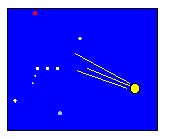 |
Astronomy 101 Problem Set #10 |  |
This Problem Set is due by 1:00 pm on Thursday, 1 December
 |
Astronomy 101 Problem Set #10 |  |
This Problem Set is due by 1:00 pm on Thursday, 1 December
Problem #1: The Kuiper Belt is a collection of comet-sized junk which orbits the Sun with nearly circular orbits of typical radius 35 A.U. It is surmised that this reservoir of material is the source of the the so-called short period comets which occasionally transit the inner solar system. What is the period of the nearly circular orbits of these objects?
Problem #2: In order for a Kuiper belt object to become a short period comet that enters the inner solar system, the eccentricity of its orbit has to change from about 0 to pretty close to 1. Suppose this magically happens, and the orbit of a Kuiper belt object changes from a nearly circular orbit with radius 35 A.U. to a highly elliptical orbit with eccentricity of nearly 1. Suppose further that the new orbit has aphelion (point farthest from the Sun) of 35 A.U., and perihelion (point closest to the Sun) of just about 0.8 A.U.
a) What is the period of this new comet?
b) What is the eccentricity of this comet's orbit?
Hint: Draw a picture!
Problem #3: Your textbook tells us that
there are approximately 1 million asteroids of diameter 1 km or
larger, and that together their mass is approximately 2% of the mass
of the Moon. If we assume that the "average" asteroid is a sphere with
diameter 10 km, then what is the average density of the "average"
asteroid? Express your answer in kg/m3 so you can compare
it to densities you know. Based on this result, what do you think most
asteroids are made of?
Hint: Pretend that 1) all asteroids are exactly the same size and
density, 2) that there are 1 million of them, and 3) together they
account for the quoted mass.
